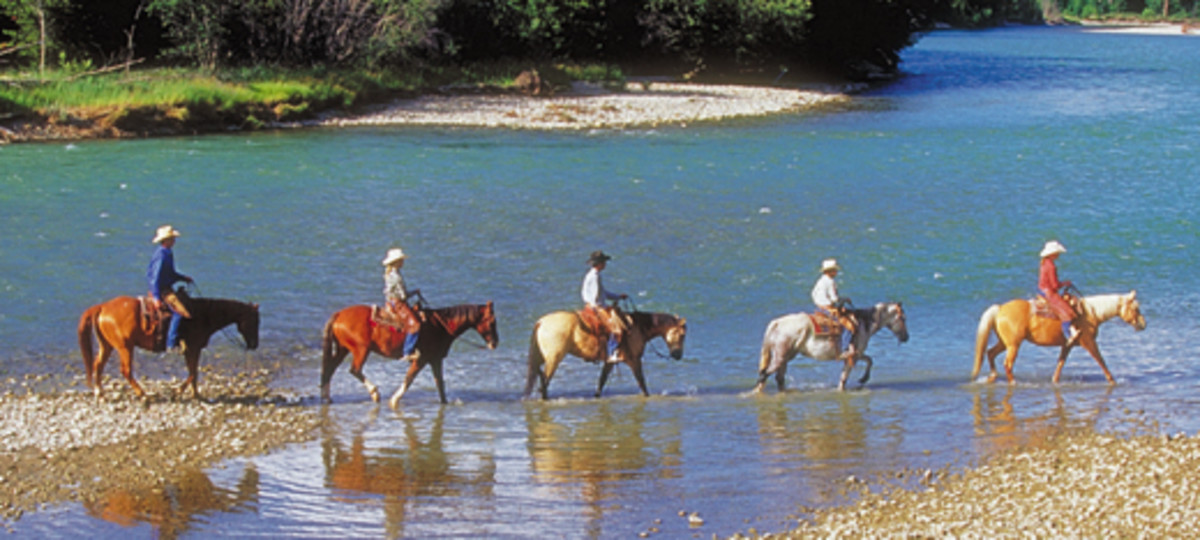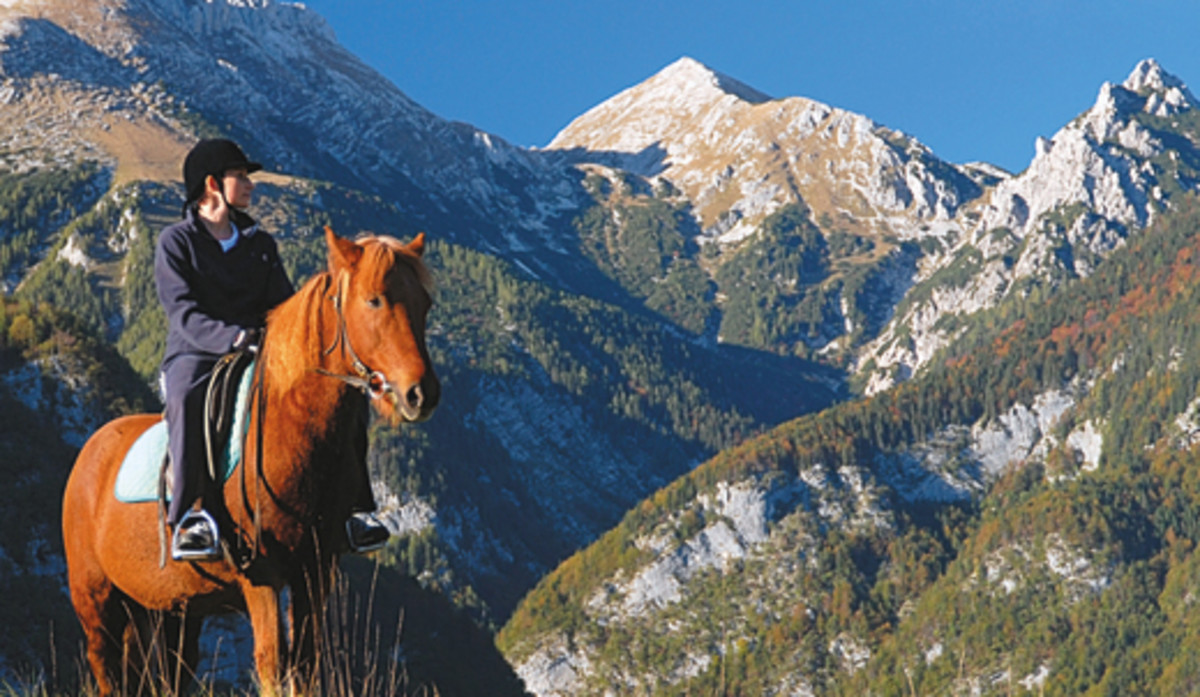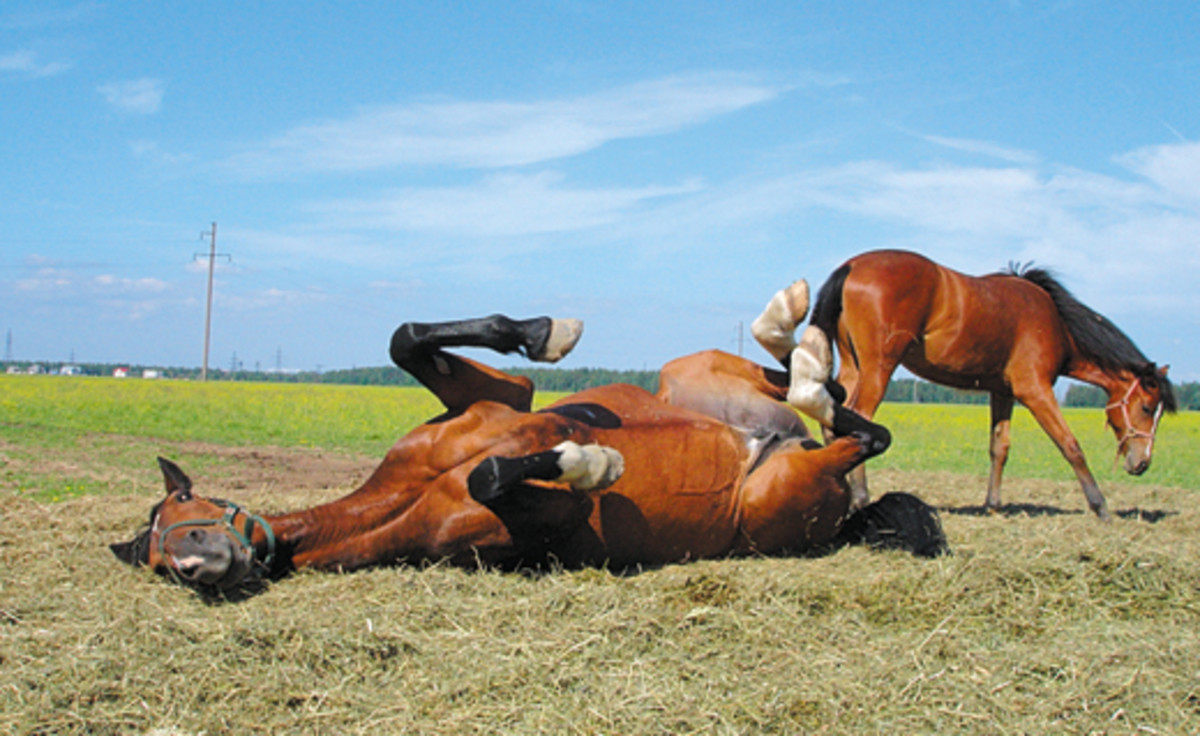Is your trail horse getting a little out of shape, with your busy schedule? Or, are you ready for adventure with a new equine trail partner? Conditioning your horse for trail work is an art, as well as a science. Here, we’ll give you seven canons of conditioning, designed to help you properly condition your trail horse: properly warm him up and cool him down; exercise him regularly; increase the work gradually; do hill work; slowly adjust to altitude; watch for trouble; and give him time off.
We’ll help you focus on keeping your horse sound and happy in his work, without overworking or injuring him. To check for indications of fatigue, dehydration, and equine exertional rhabdomyolysis (tying up) -and what to do should you spot a problem – see “Trouble Signs” on page 84.
Important note: Before you begin a conditioning program, have your horse thoroughly evaluated by your veterinarian, and work with him or her to refine a program right for your particular horse.
Canon #1: Properly warm him up and cool him down.
Why it’s important: Warming up your horse before you work him improves circulation and oxygen intake, helps limber muscles and tendons so they are more elastic (and less likely to suffer an injury), and helps him prepare mentally for the task ahead. A warm-up also works out any previous muscle soreness or stiffness. Plus, mild exercise increases natural lubrication of joints.
Proper cool-down helps prevent muscle stiffness and soreness after a ride, as the continuing mild exercise flushes wastes from the working muscles. A cool-down also allows your horse’s heart to drop back toward a resting rate, keeps fluid from accumulating in legs and joints, and helps all his body systems return to normal.

Recommended routines: To warm up your horse, walk (or walk/trot) him briskly for five to 10 minutes. Then limber him by circling and cantering/loping for a few strides on each lead. Avoid speed. Warm him up only until you see him starting to break a light sweat; his coat will feel slightly moist to the touch. If he breaks into a real sweat, you’ve overdone it; warm him up more slowly in the future. On cold days, use a rump rug to keep his large hindquarter muscles warm.
Give your horse about 10 to 30 minutes to cool down. The exact time he needs depends on the length and intensity of your ride, as well as his fitness level. Do progressively slower work on your way home. If you were galloping, trot for several minutes to keep the blood circulating. (Circulation brings overheated blood to the body surface where it cools and helps flush muscle waste.) Then bring him down to a walk until he stops sweating, dries off, and his chest feels cool.
If he’s still quite warm, dismount, loosen the cinch/girth, and lead him the rest of the way home. Or, return home, take off the tack, apply a halter, and lead him until he’s cool. Don’t put him away until he’s completely cooled down and his heart rate has returned to what’s normal for him. The average resting heart rate for a horse is about 26 to 33 beats per minute; a horse’s after-exercise recovery heart rate is higher and individual for each horse.
Find out what’s normal for your horse by checking his resting heart rate every morning for five days straight, then average those numbers. Note that a higher or lower rate than normal can indicate a health problem; if your horse’s resting heart rate is abnormally high or low (for him) call your veterinarian.
The easiest way to monitor your horse’s heart rate is via a heart-rate monitor, which automatically counts beats per minute and shows the results via a transmitter to a wrist display you wear like a watch. One recommended equine model is Polar Vet Check (available from Equine Performance Products, 866/378-4476; www.equineperformanceproducts.com).
Or, you can place a stethoscope behind your horse’s left elbow, count the beats for 15 seconds (each “lub-dub” counts as one beat), and multiply by four to get beats per minute.
Note that on cold days, your horse might not sweat much immediately after exercise, but his core temperature might still be elevated; he’ll break out in a sweat later. As the weather cools, keep a close watch on his heart rate (above) rather than his sweat level.
Canon #2: Exercise your horse regularly.
Why it’s important: Regular exercise gets your horse in shape. A fit horse will be better able to carry you on your trail-riding adventures. He’ll also be less prone to injury or serious repercussions from overwork.
Recommended routine: If your horse is in a pasture, where there’s room to self-exercise, he might stay in shape with weekly rides. But if he’s in a stall, he’ll need daily turnout in a large, enclosed area with good footing, plus an under-saddle workout two to three times per week; more if you’re trying to build his stamina.
Canon #3: Increase the work gradually.
Why it’s important: Overworking your horse before he’s fit can lead to soft-tissue damage. Overwork can also injure his joints. If you push him beyond his limits of endurance and to the point of dehydration or exhaustion, you can even endanger his life.
Recommended routine: Before you push your horse hard, give him enough time to build up his internal systems. Note that his respiratory and cardiovascular systems will take longer than his muscles to get in shape. He’ll also need to develop a working mentality, in which he works steadily without wasting energy jigging or prancing.
Keep in mind that a green horse or one that’s never been highly conditioned will need a longer and more gradual conditioning program than a horse that’s been in shape before. Don’t expect your unfit horse to reach his top potential in one season.
If your horse is very soft, begin with a few days of short daily rides at the walk before you actually start conditioning. He might need as long as two months to regain fitness; the safest way is to start slowly, at a level or so below where you left off last year.
Monitor his response to being worked and his recovery heart rate (as explained in Canon #1) so you can gauge how quickly to increase his work. With a heart monitor, you’ll be able to keep an eye on his heart rate continually while you ride. His working heart rate should be between 120 and 160 beats per minute. Be alert for signs of fatigue, and take it one step at a time.
Post-workout, if it takes longer than a half-hour for his heart rate to return to 64 beats per minute, you’re pushing him too hard; back off. As you condition him slowly, his recovery time will decrease as his fitness level increases.
Start with short, easy rides at a walk. Gradually add more miles at a walk, then add some trotting and loping/cantering. Ride in open country over natural terrain. At first, ride him every other day or every three days. After a few weeks, his body will start replacing fat with muscle. Once he’s in shape, take him on a longer ride once a week. Avoid overdoing his workouts, which can lead to mental burnout.
Tip: A fit horse has thin, watery sweat – practically tasteless and odorless. Thick, smelly, salty sweat that lathers is a sign of a soft horse. His muscles are not yet working efficiently; too many waste products are being produced and eliminated through sweat. Touch a fingertip to your horse’s sweat, then taste it. If it’s very salty, he isn’t yet in shape.
Canon #4: Do hill work.
Why it’s important: Hill work helps your horse build strength, lung capacity, and stamina by pitting his body weight against the force of gravity. The effort to climb makes his heart pump faster, and makes his lungs and muscles work harder than they do on flat ground. A horse conditioned on flat ground won’t have the necessary muscle strength to carry you over hills and will tire quickly. He’s also at risk for damaging his joints, tendons, and muscles, because he’s not accustomed to steep, uneven terrain.
Recommended routine: Start slowly, so your horse won’t pull or tear soft tissue, or strain a joint. Walk uphill to strengthen his legs, then progress to trotting uphill. Galloping uphill works his rump muscles, but only do so if he’s very fit, and don’t overdo it or he may become injured.
Also travel across hillsides occasionally to improve your horse’s coordination, balance, and strength to handle uneven ground and bad footing. When you go around the face of a steep hill, especially if footing is loose or uneven, he’ll develop dexterity to keep his balance, picking up each leg and moving it around the other. This is good lateral (side-to-side) exercise.
Canon #5: Slowly adjust to altitude.
Why it’s important: Oxygen diminishes at higher elevations, making it difficult for your horse to perform optimally.

Recommended routine: Give your horse two weeks to adapt to high altitudes before you ask him to take you on a long ride. It takes this long for his body to create enough red blood cells to handle the reduced oxygen level. If you can’t take that much time off, leave your horse at home, and find an outfitter whose horses live at the higher altitude in the area you plan to ride. (For more information, see “Altitude Adjustment,” What’s up, Doc? January/February ’07.)
Canon #6: Watch for trouble.
Why it’s important: If you can catch a problem early, and slow down or stop before your horse is in serious trouble, he’s more likely to recover quickly. But if he’s already seriously compromised before you end the ride, he can suffer further damage, which can be fatal.
Recommended routine: Be alert for early warning signs of problems, such as signs of fatigue, dehydration, and tying up. (See “Trouble Signs,” on page 84.) Note that fatigue at this level of conditioning is usually self-limiting; that is, your horse will be fine if you allow him to rest. However, it might take an hour for him to rest enough to get back home. Dismount, remove the saddle, and let him relax. Allow him to graze on safe grass. Nontoxic, green grass is the best thing for a tired, dehydrated horse, as it contains moisture and electrolytes (key minerals lost in sweat).
Encourage your horse to drink throughout your ride, especially if he seems tired, overheated, or dehydrated. Water is vital to all of his bodily functions, and he needs water to rid himself of excess body heat. Give him free access to clean water. Encourage him to drink at stream crossings.

Canon #7: Give your horse time off.
Why it’s important: Your horse will function optimally both mentally and physically if you allow him a day off now and then. If you overdo, you’ll tear down his body tissues rather than building them up. He can also burn out mentally and start to resist. Time off helps him to return to work eager and happy.
Recommended routine: How much time off you give your horse depends on his stage of conditioning and how much work he did on the previous ride. After a long ride, he’ll need time to repair damaged muscles.
Use this formula: Grade your most recent ride on a scale of 1 to 5; 1 is equivalent to a 10-mile, pack-your-lunch trail ride, and 5 is equivalent to a five-day endurance ride. This grade is the number of days off you should give your horse after a ride. If he’s stalled, turn him onto a pasture or paddock where he can move freely.
Note that if you’re on a relaxed, multi-day trail ride or camping trip, your conditioned horse should be able to carry you every day. Most recreational trail rides involve mostly walking, with numerous stops. If your horse gets 12 to 15 hours of rest out of 24, he should be ready to go the following day






